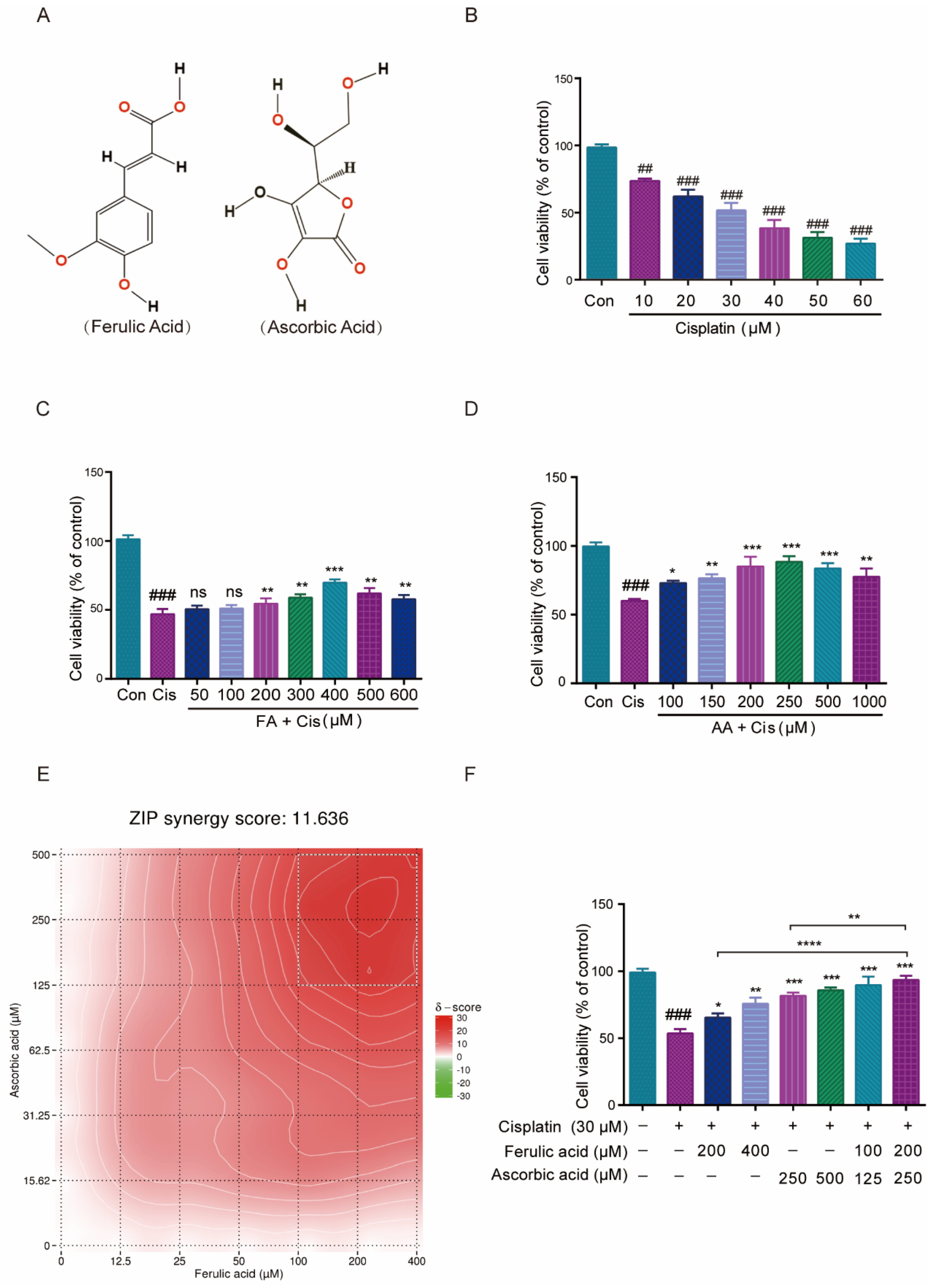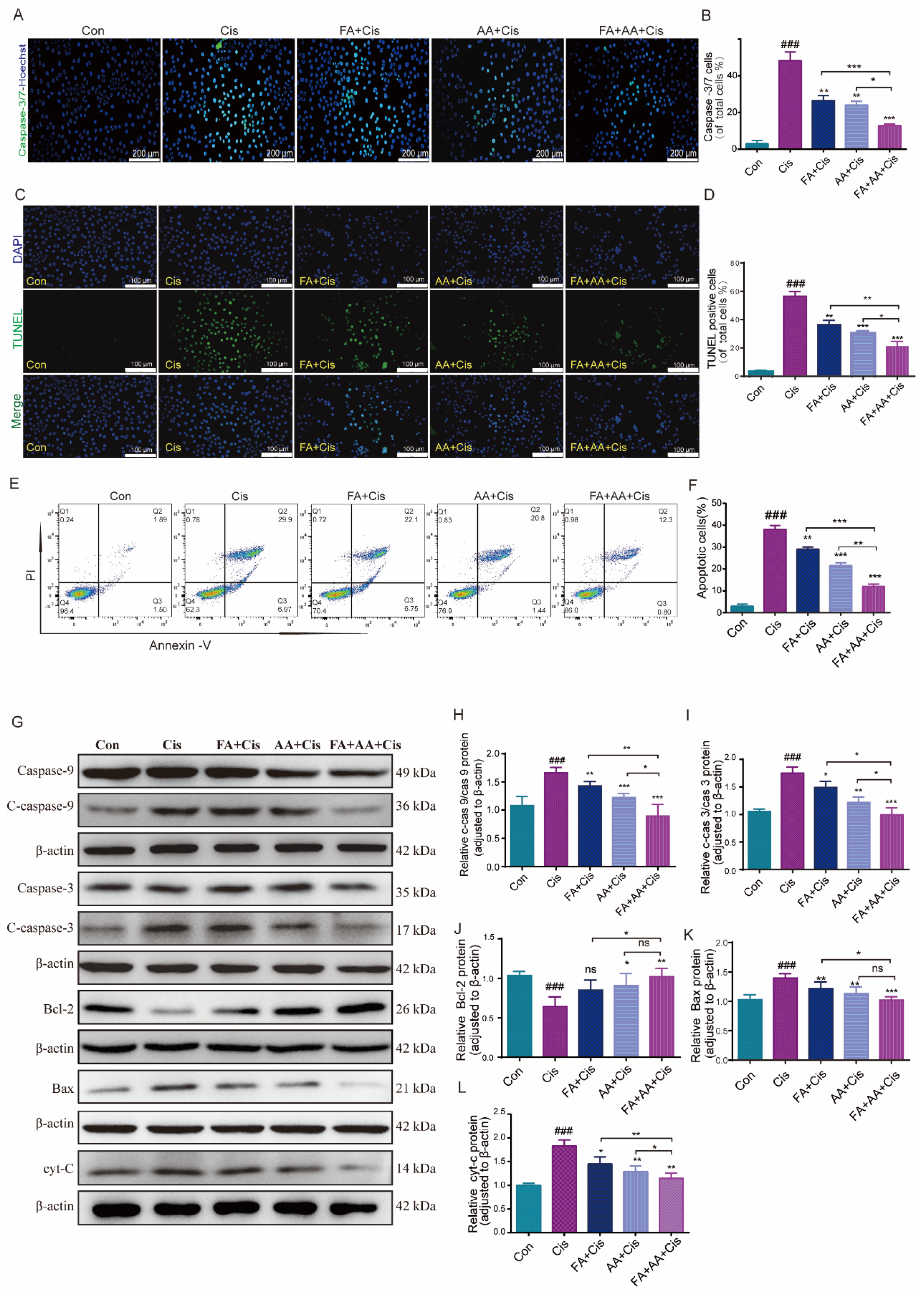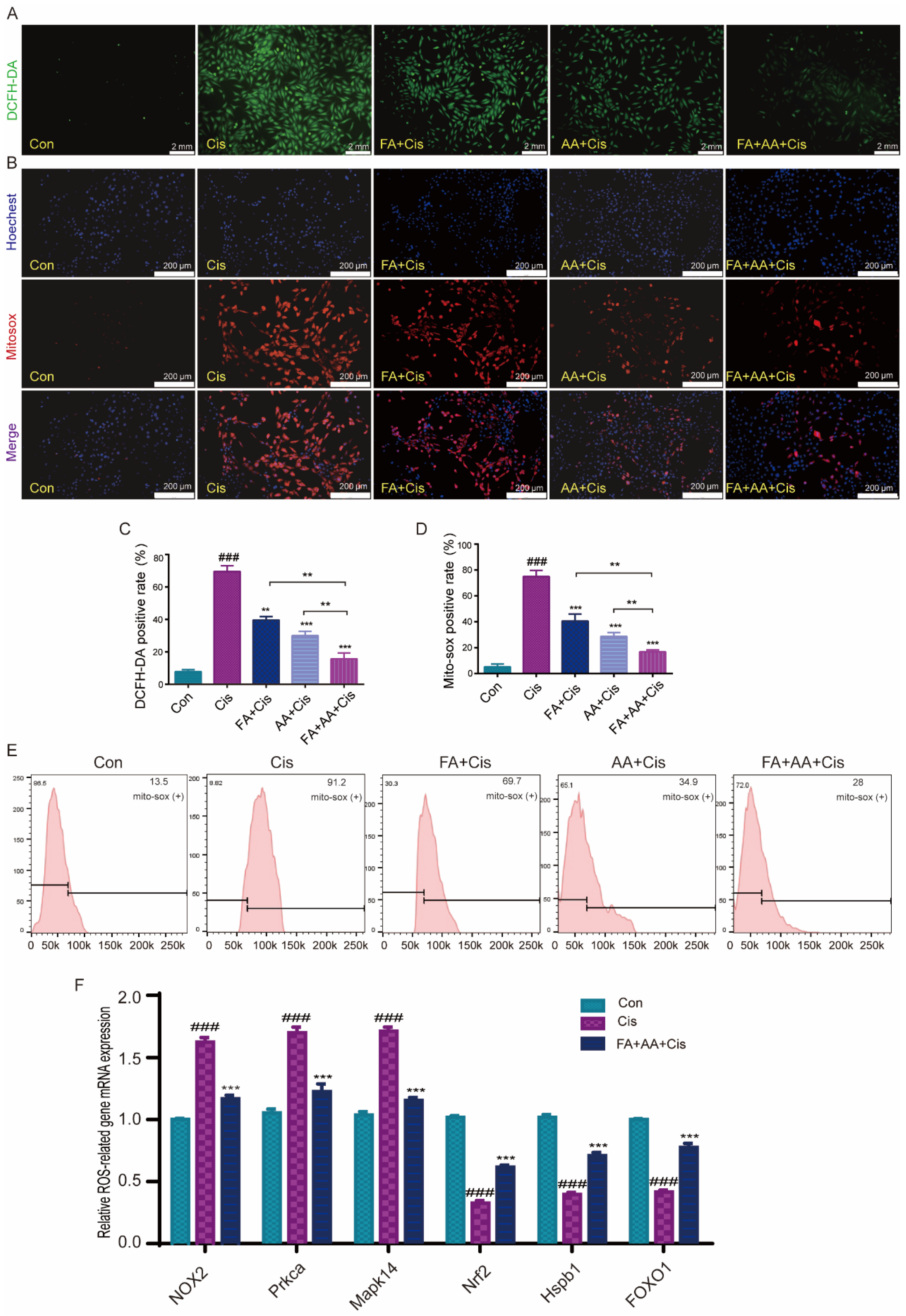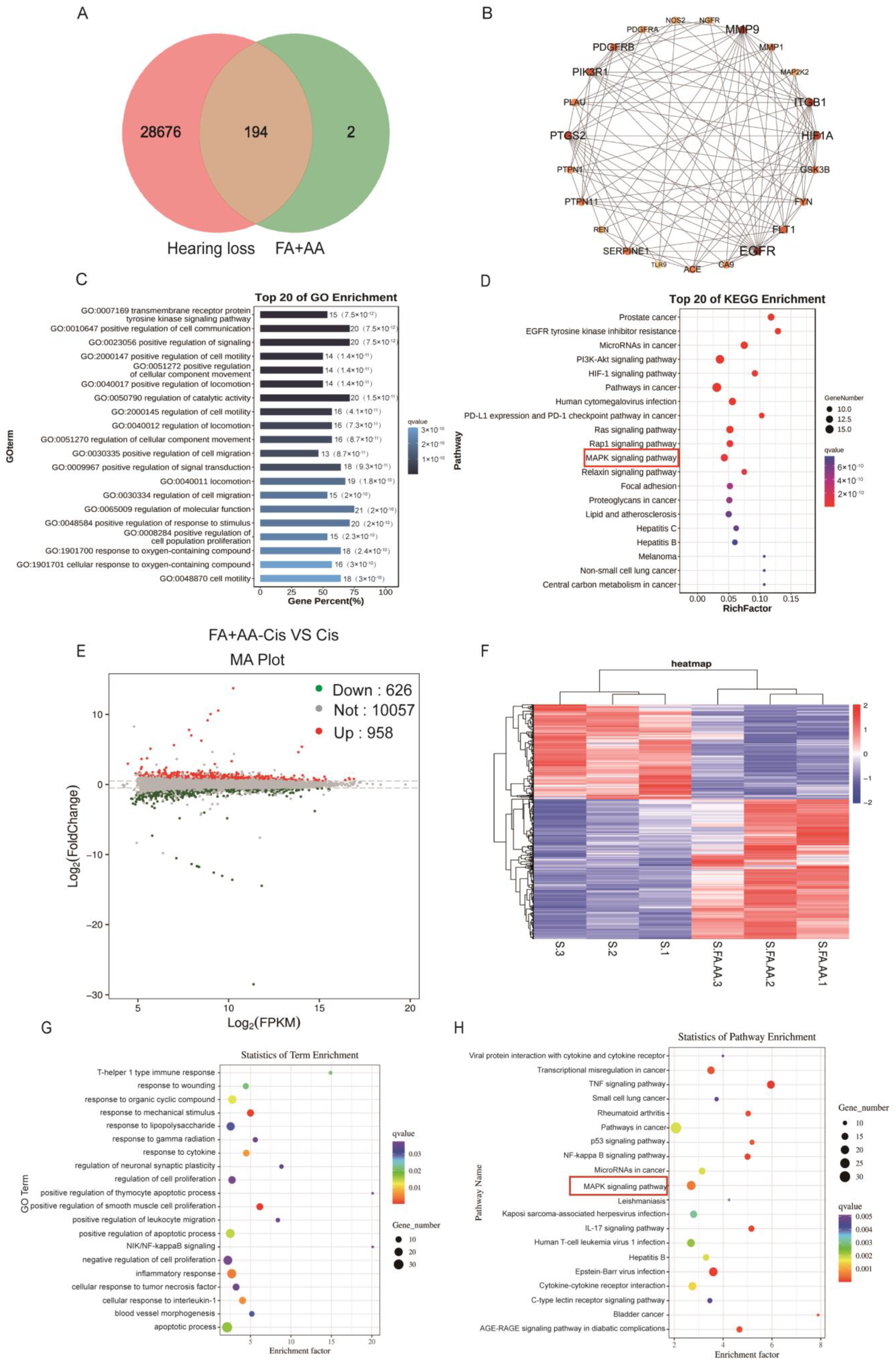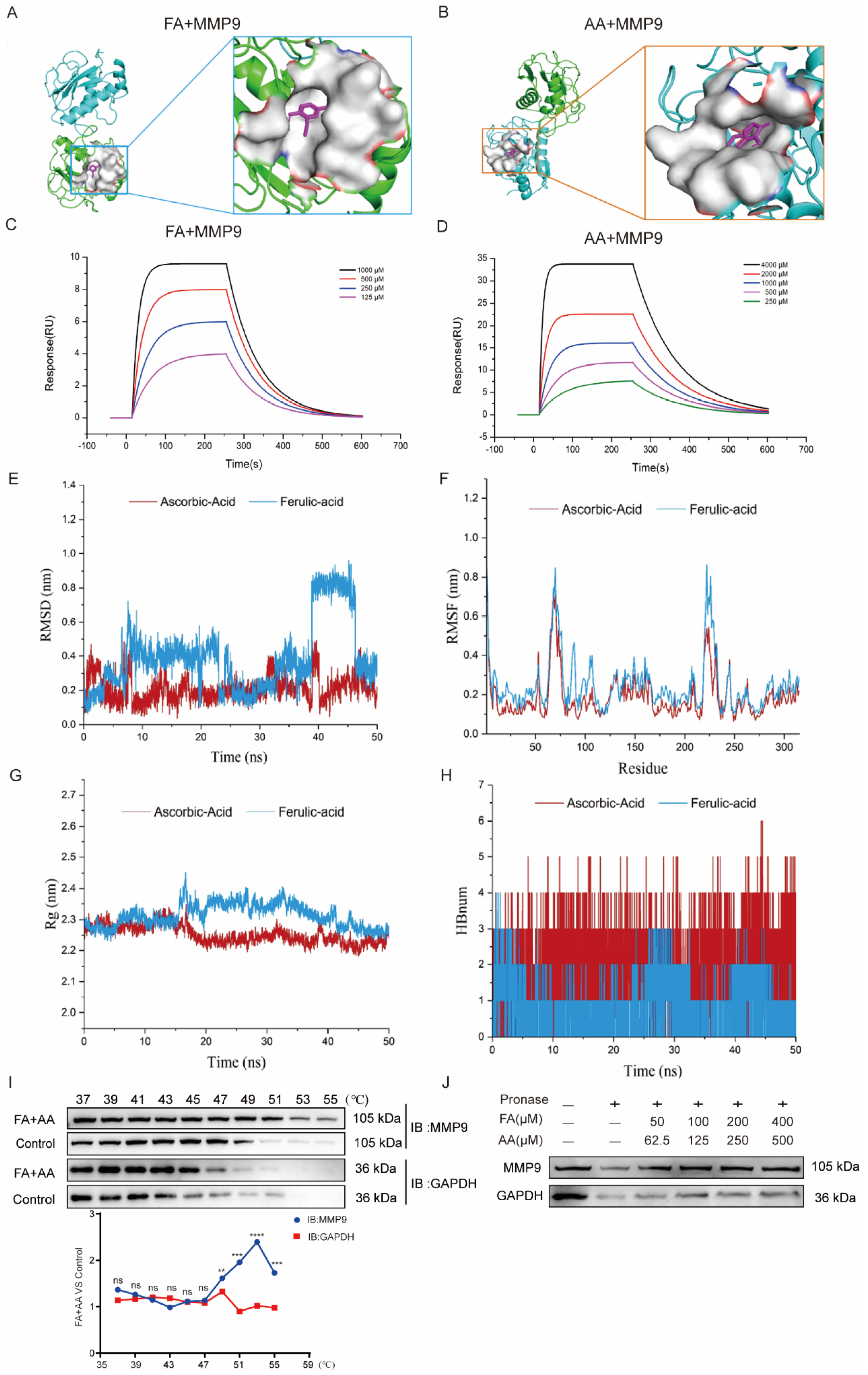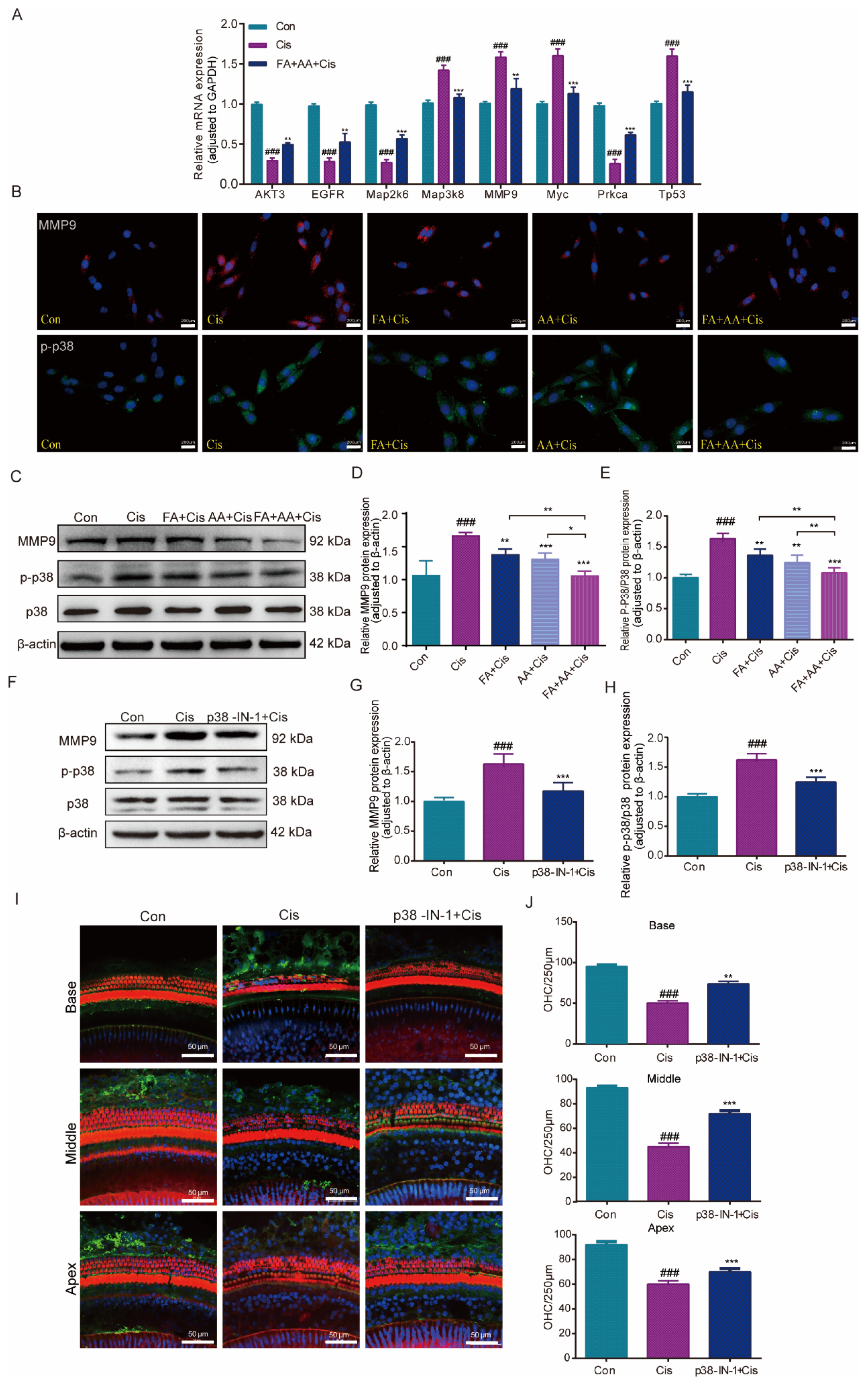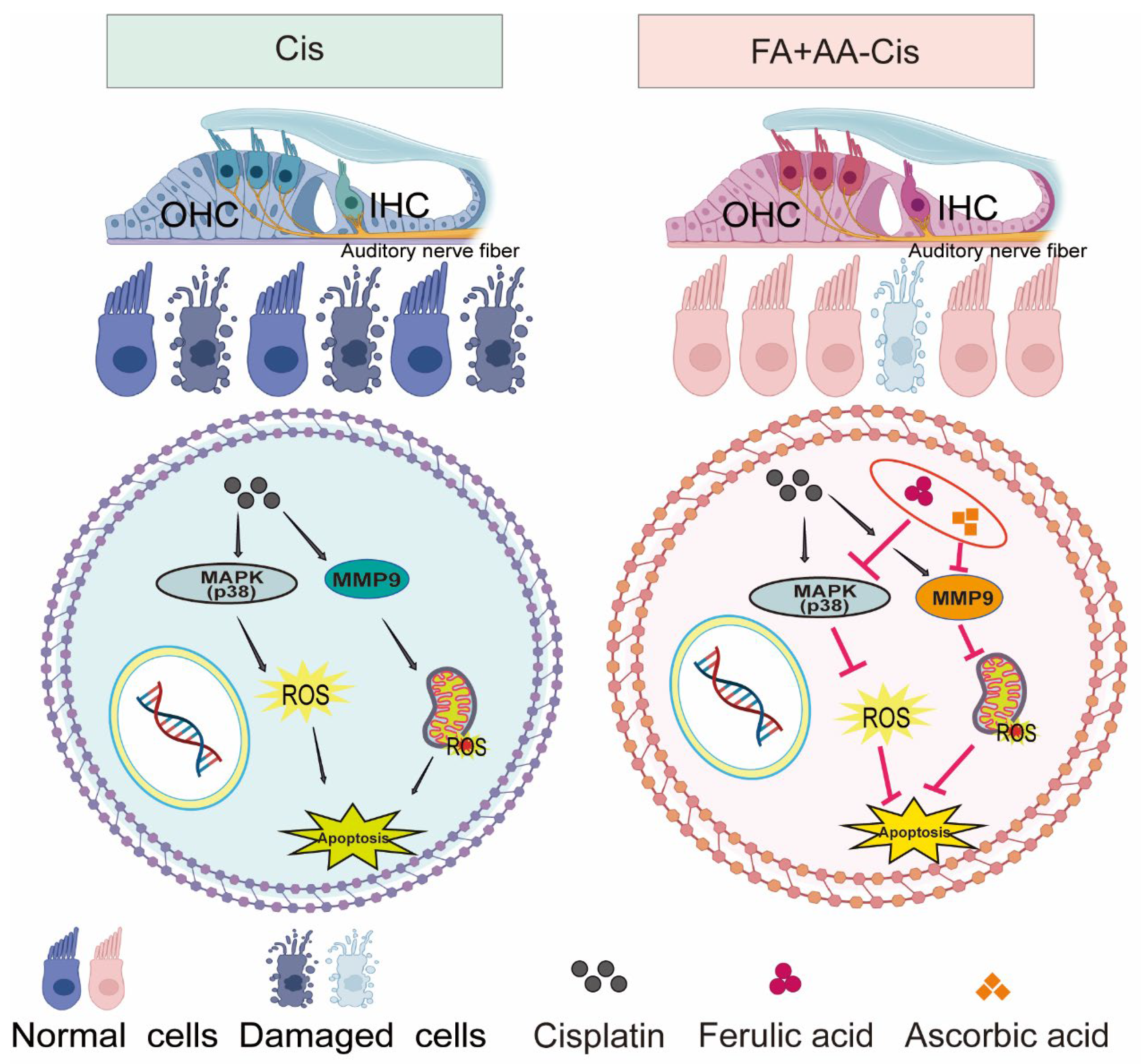1. Introduction
Cis is a platinum-based chemotherapeutic agent widely used to treat various cancers. However, its clinical utility is limited by severe side effects, particularly ototoxicity and nephrotoxicity, which often necessitate dose reduction or treatment discontinuation. Nearly 1 million people annually are exposed to antineoplastic drugs, with chemotherapy-induced hearing loss estimated to affect 500,000 cases per year [
1]. The mechanisms underlying Cis-induced ototoxicity remain incompletely understood but involve DNA damage, oxidative stress, and cochlear cell apoptosis. Cisplatin forms interstrand crosslinks in DNA, triggering (ROS) overproduction, lipid peroxidation, antioxidant depletion, calcium influx, and, ultimately, apoptosis of cochlear hair cells, particularly outer hair cells [
2,
3,
4]. A key contributor to Cis-induced hearing loss is oxidative stress, which damages cochlear structures and activates inflammatory pathways [
5,
6]. These pathways further amplify inflammation and apoptosis via caspase-8 activation [
7,
8]. Given these mechanisms, antioxidants such as glutathione, N-acetylcysteine (NAC), and sodium thiosulfate have been explored as protective agents with varying success [
9,
10,
11].
MMP9 a zinc-dependent endopeptidase, plays a crucial role in extracellular matrix (ECM) remodeling and cellular processes such as inflammation, apoptosis, and oxidative stress responses [
12]. Elevated MMP9 exacerbates tissue damage by degrading ECM components, rendering cells more susceptible to oxidative injury [
13,
14,
15]. In the auditory system, MMP9 is expressed in the organ of Corti, pillar cells, and spiral ganglion neurons, suggesting a potential role in ototoxicity [
16,
17,
18,
19]. MMP9 may serve as a predictor of cochlear implant outcome in the treatment of prelingual deafness [
20]. In the model of cochlear blood–labyrinth barrier injury caused by cisplatin, the expression of MMP9 was increased in peristriatal cells. However, the role of MMP9 in Cis-induced damage in cochlear hair cells remains unclear [
21]. Notably, MMP9 is regulated by the MAPK pathway, particularly p38 MAPK, which is activated by oxidative stress and inflammation [
22,
23]. The inhibition of MMP9 has been shown to improve recovery in neural injury models, raising the possibility that targeting MMP9/MAPK signaling could mitigate Cis-induced ototoxicity [
22].
Given the limitations of current protective strategies, natural antioxidants like FA and AA have emerged as promising candidates. FA attenuates Cis-induced cytotoxicity by scavenging ROS and boosting endogenous antioxidants [
24], while AA has been shown to reduce ototoxicity in models of drug-induced hearing loss [
25]. In other models, FA and AA exert a synergistic effect on each other, for instance, isoproterenol-induced myocardial infarction in rats, cardiac toxicity caused by β-adrenergic catecholamines in rats, and skin aging caused by light irradiation [
26,
27,
28]. Since MAPK/MMP9 signaling is a critical mediator of Cis-induced damage, we hypothesize that FA and AA may protect against ototoxicity by modulating this pathway.
Although FA and AA have been individually investigated in Cis-induced ototoxicity, their combined effects on MMP9 through p38 MAPK pathway modulation have not been systematically examined. This study investigates whether FA and AA exert protective effects by suppressing oxidative stress and MMP9 activation via the MAPK pathway, offering potential therapeutic strategies to prevent Cis-associated hearing loss.
2. Materials and Methods
2.1. Materials
Cis (purity ≥ 99.0%), FA (mixture of isomers, analytical standard), and AA (ACS reagent, ≥99%) were purchased from Sigma-Aldrich (St. Louis, MO, USA). Primary antibodies against Bax (ab32503), Bcl-2 (ab32124), Caspase-3 (ab32351), MYO7A (ab150386), Caspase-9 (ab202068), and Cytochrome C (cyt-C) (ab133504) were purchased from Abcam (Cambridge, UK). Anti-p38 (GB154685-100), anti-p-p38 (GB153380-100), and anti-MMP9 (GB11132-100) were purchased from Sevier Biotechnology Co., Ltd. (Wuhan, China). FITC-Phalloidin (ab176753) and TRITC-Phalloidin (ab176757) were purchased from Abcam (Cambridge, UK). Dulbecco’s modified Eagle’s medium (DMEM), fetal bovine serum (FBS), and penicillin/streptomycin were purchased from Gibco (Grand Island, NY, USA). An apoptosis detection kit was purchased from Vazyme Biotech Co., Ltd. (Nanjing, China). Trypsin was purchased from HyClone Corporation (Logan, UT, USA). The Annexin V-FITC/PI apoptosis kit was manufactured by MultiSciences (Lianke) Biotechnology Co., Ltd. (Hangzhou, China). CellEvent Caspase 3/7 Green Detection Reagent was obtained from Thermo Fisher Scientific (C10423) (Waltham, MA, USA). MitoSOX Red was obtained from Thermo Fisher Scientific (M36008). Dimethyl sulfoxide (DMSO), RIPA buffer, and phenylmethylsulfonyl fluoride (PMSF) were purchased from Solarbio Science & Technology Co., Ltd. (Beijing, China). Paraformaldehyde (4%) and enhanced chemiluminescence detection (ECL) reagents were purchased from Biosharp (Hefei, China). A One-step TUNEL Apoptosis Detection Kit (C1088) was purchased from Biyuntian Biotechnology Co., Ltd. (Shanghai, China). p38 MAPK-IN-1 (HY-12839) was purchased from MedChemExpress (Monmouth Junction, NJ, USA). Anti-β-actin and Anti-GAPDH were purchased from Zhong Shan-Golden Bridge Biological Technology Co., Ltd. (Beijing, China). Annexin V-FITC/PI Apoptosis Kit was purchased from Multisciences (Lianke) Biotech Co., Ltd. (Hangzhou, China). The No. 8 cell clamp was purchased from Guangdong Sude Technology Co., Ltd. (Dongguan, China).
2.2. Animal Experiments
All the animal experiments and procedures were approved by the Institutional Animal Care and Use Committee of Shihezi University and complied with the Animal Experiment Ethics Regulations of Shihezi University. Eight-week-old C57BL/6J mice were purchased from Skobes Biotechnology Co., Ltd. (Anyang, China). To investigate the protective effects of FA and AA in vivo, 1 mL of preheated sterile saline was intraperitoneally injected one day before the administration of Cis and/or FA and AA. The mice were intraperitoneally injected with FA at a dose of 100 mg/kg, and the mice were intraperitoneally injected with AA at a dose of 150 mg/kg. Two hours later, 30 mg/kg Cis was intraperitoneally injected once. After Cis administration, mice in all the groups (the Con group, Cis group, FA + Cis group, AA + Cis group, and FA + AA + Cis group) were intraperitoneally injected with 1 mL of prewarmed saline twice a day for seven consecutive days to alleviate nephrotoxicity and dehydration, and then the mice were subjected to auditory brainstem response (ABR) tests. The dose of Cis and the procedure that was used were chosen based on a previous study of mice with hearing loss [
29].
2.3. Cell Culture
HEI-OC1 cells were kindly donated by Professor Renjie Chai, School of Life Sciences, Southeast University, Nanjing, China. HEI-OC1 cells were cultured in Dulbecco’s modified Eagle’s medium (DMEM) supplemented with 10% fetal bovine serum (FBS) at 33 °C and 5% CO2 in a humidified atmosphere. The cells were allowed to reach approximately 80% confluence before the following experiments were performed. The target concentration of Cis was determined and administered to HEI-OC1 cells to induce cell apoptosis; FA (100 μM or 200 μM) and AA (125 μM or 250 μM) were administered to HEI-OC1 cells with Cis. Five groups were included in this study: the HEI-OC1, HEI-OC1 + Cis, HEI-OC1 + FA + Cis, HEI-OC1 + AA + Cis, and HEI-OC1 + FA + AA + Cis groups. The HEI-OC1-alone group was set as the normal control.
2.4. Cochlear Explants Culture In Vitro
The cochlea of newly born C57BL/6 mice (3–4 days old) was placed in pre-cooled PBS after removal under a stereomicroscope. The cochlea shell, which had not been fully calcified, was gently peeled off with No. 8 forceps and laid face up on a cell-tak-coated coverslip in the culture medium of DMEM/F12 containing N2/B27 (Thermo Fisher Scientific, Waltham, MA, USA) and ampicillin. The cultures were incubated overnight at 37 °C in a humidified environment containing 5% CO2.
2.5. Cell Viability Assay
Cell viability was assessed using a CCK-8 assay. HEI-OC1 cells were seeded in a 96-well plate at an optimal density (5000–6000 cells per well) in 100 µL of culture medium and allowed to adhere and grow for 24 h under standard culture conditions (33 °C, 5% CO2). Serial dilutions of the test compounds (FA and AA) were prepared in the culture medium and the plates were incubated for the desired treatment duration (24 h) under standard culture conditions. Each group’s HEI-OC1 cells were washed with prewarmed Phosphate-Buffered Saline (PBS) before adding CCK-8 solution and incubating for 2 h at 33 °C in a CO2 incubator. The absorbance was measured at 450 nm using a zymograph (Bio-Rad Laboratories, Hercules, CA, USA). Each group was tested three times.
2.6. Apoptosis Analysis
TUNEL apoptosis detection kit (Multi Sciences, Hangzhou, China) was used. Briefly, cells were washed once with prewarmed PBS, fixed in 4% paraformaldehyde for 30 min, and then washed again. The cells were incubated with 0.3% Triton X-100 for 5 min at room temperature. In each sample, 5 μL of TDTase is added to 45 μL of Fluorescent Labeling Solution and incubated in the dark at 37 °C for 60 min. The cells were washed three times with PBS and observed under a fluorescence microscope. According to the instructions of the Annexin V-FITC/PI Apoptosis Kit, 5 μL of Annexin V-FITC and 10 μL of PI were added to samples in each group; the stained cells were detected by flow cytometry (BD FACS Aria III, San Jose, CA, USA), and the apoptosis rate was analyzed by FlowJo V10 software.
2.7. ROS Assay
DCFH-DA and MitoSox Red (Life Technologies, Invitrogen, Waltham, MA, USA) were employed to determine intracellular and mitochondrial ROS levels, respectively. To visualize ROS generation, HEI-OC1 cells were seeded in 12-well plates at 15,000 cells per well and treated as indicated. Following drug intervention, cells were doubly stained with 20 μmol/L DCFH-DA and 5 μmol/L MitoSox-Red. After 30 min in the dark, the cells were stained with Hoechst 33342 for 10 min to reveal the nuclei. The cells were washed three times with PBS and examined using a Zeiss fluorescence microscope (Jena, Germany).
2.8. RNA-Seq and Quantitative PCR
RNA-seq samples were divided into two groups (n = 3), the model group (Cis 30 μM) and the treatment group (FA 200 μM, AA 250 μM, Cis 30 μM). RNA was extracted using the RNeasy Mini Kit (Qiagen, Valencia, CA, USA) according to the manufacturer’s instructions. A NanoDrop 2000 spectrophotometer (Thermo Fisher Scientific) was used to determine RNA purity and quantity. The assessment of RNA integrity was performed using an Agilent 2100 Bioanalyzer (Agilent Technologies, Santa Clara, CA, USA). A TruSeq Stranded mRNA LT Sample Prep Kit (Illumina, San Diego, CA, USA) was used for library construction according to the manufacturer’s instructions. The Illumina HiSeq X Ten platform was used for library sequencing and for generating 150-bp paired-end reads. Raw reads (FASTQ format) were first processed with Trimmomatic, and low-quality reads were removed to obtain clean reads. Differential expression analysis was performed using the DESeq2 (2012) R package. p < 0.05, fold change > 2 and FDR < 0.01 indicated significant differential expression. The raw sequencing data were deposited in the NCBI Sequence Read Archive under the following accession numbers: the Cis group: SRR32423921, SRR32423922, SRR32423923; the FA+AA+Cis group: SRR32423918, SRR32423919, SRR32423920.
2.9. Western Blotting
After treatment, the cells were washed in cold PBS and lysed with RIPA buffer containing protease inhibitors and phosphatase inhibitors on ice for 20–30 min. The protein concentrations were determined using a BCA kit (Thermo Fisher Scientific, Waltham, MA, USA). Equal amounts of proteins were separated on a Sodium Dodecyl Sulfate Polyacrylamide Gel Electrophoresis and transferred to Polyvinylidene Fluoride (PVDF) membranes. The membranes were then incubated with specific primary antibodies (overnight at 4 °C). Primary antibodies targeting the following proteins were used in this study: β-actin (1:1000), GAPDH (1:1000), Bcl-2 (1:1000), caspase3 (1:1000), cleaved-caspase3 (1:1000), caspase9 (1:1000), cleaved-caspase9 (1:1000), Bax (1:1000), cyt-C (1:1000), MMP9 (1:1000), p38 (1:1000), and p-p38 (1:1000). The next day, the PVDF membranes were incubated with a horseradish peroxidase-labeled secondary antibody (1:10,000) at room temperature for 2 h. After being washed with TBST, the PVDF membranes were incubated with a chemiluminescent solution from the ECL kit and scanned with a chemiluminescent imager. The images were saved for quantitative analysis.
2.10. Immunofluorescence
Fixed cochleae and cells were permeabilized (0.5% Triton X-100 in PBS; 30 min), blocked (0.5% BSA in PBST; 1 h), and incubated with primary antibodies against MMP9 (1:250) and p-p38 (1:250) overnight at 4 °C. Then, the samples were treated with a secondary antibody fluorescent antibody in the dark for 2 h. 4′,6-Diamidino-2-phenylindole (DAPI; Sigma Aldrich) was employed to stain for 5 min. For phalloidin staining, the fixed cochlear specimens were treated with phalloidin-iFuor 594 Reagent (Abcam) (1:1000) or phalloidin-iFuor 488 Reagent (Abcam) (1:1000) for 120 min in the dark and subjected to DAPI counterstaining. Differences in staining were examined under a microscope. CellEvent Caspase 3/7 Green Detection Reagent (Thermo Fisher Scientific, C10423) was used. The stock solution was diluted 1:400 with growth medium, and the cells were stained for 30–60 min. The cell nuclei were stained with Hoechst 33342 for 5–10 min in the dark. The cells were washed with PBS thrice and evaluated with a fluorescence microscope. A One-step TUNEL Cell Apoptosis Detection Kit (Beyotime, Shanghai, China, C1088) was used. The cells were fixed with 4% paraformaldehyde for 30 min, washed once with PBS containing 0.3% Triton X-100 PBS, and incubated at room temperature for 5 min. TUNEL solution was added to the sample and incubated at 37 °C for 60 min in the dark. The cells were washed with PBS thrice. The cell nuclei were stained with DAPI for 5 min in the dark. The cells were washed with PBS thrice and evaluated with a fluorescence microscope.
2.11. ABR Measurements
Each group of anesthetized mice (100 mg/kg ketamine and 25 mg/kg thiazide sodium, i.p.) conducted ABR analysis to test hearing thresholds before and after drug delivery. Hearing thresholds at four frequencies (8, 16, 24, and 32 kHz) were measured using a TDT system (3 Technology, Gainesville, FL, USA). Three electrodes (stimulating, reference, and ground) were usually placed subcutaneously at the cranial apex, ipsilateral mastoid, and nasal root. The parameters for the elicited responses and acquired signal were as follows: Tone burst length is 5 ms, rise-fall time is 0.5 ms, stimulus frequency is 21.37/s, stacking fold (superposition times) is 500–1000, magnification is 20, bandpass is 0.3–3 kHz, sound intensity fluctuation is 5 dB, and SPL amplitude is 20–95 dB.
2.12. Network Pharmacology Analysis
Information on FA and AA was retrieved from the PubChem database, and their targets were predicted using the SwissTarget Prediction and Super-PRED databases. The GeneCard human gene database, the DisGenet database, and the OMIM database were then used to obtain target genes for the diseases of interest using “hearing loss” as the search term, with the species set to human. Then, duplicate disease targets were merged and removed. Next, the screened drugs and disease targets were entered into Venny 2.1 software. Then, a protein–protein interaction (PPI) network was constructed using the STRING database, and the biological species was set to “human”. Next, the drug–disease shared targets were imported into DAVID Bioinformatics Resources 6.8 for GO biological process (BP) analysis. Finally, the KEGG pathway enrichment analysis of shared drug targets and disease targets was also performed using DAVID Bioinformatics Resource 6.8.
2.13. Docking Analysis
The enrichment of targets in signaling pathways was comprehensively analyzed, and the ability of FA and AA to bind to these targets was analyzed by molecular docking. The SDF structures of FA and AA were downloaded from the PubChem database, and the 3D structures of the core targets were downloaded from the Protein Data Bank (PDB). The Selleck website was used to determine the names of the inhibitors of the core targets, and their SDF structures were downloaded from the PubChem database. Discovery Studio 2016 (DS.2016) software was used to process the obtained 3D structures. The molecular docking of a ligand to a receptor was then performed using a built-in program LibDock. The molecular docking results were visualized as 2D and 3D structure pictures using Discovery Studio Visualization Version 4.5.
2.14. Molecular Dynamics Simulation
All-atom molecular dynamics simulations were performed based on the small-molecule and protein complexes that were obtained from the above docking as initial structures, and the simulations were performed using Gromacs 2020.6 software. The small molecules and proteins were described using the CHARMM-36 protein force field. The pdb2gmx subroutine was used to add hydrogen atoms to the system, a truncated cubic TIP3P solvent box was added at a distance of 10 Å from the system, Na+/Cl− was added to the system to balance the system charge, and, finally, the topology and parameter files that were used for the simulations were output.
2.15. Cellular Thermal Shift Assay (CETSA)
HEI-OC1 cells were treated with FA (200 μM), AA (250 μM), FA+AA (100 μM, 125 μM), or DMSO for 2 h at 37 °C. The cells were harvested in PBS containing 1% protease inhibitor and separated into 10 groups. Individual samples were cooked for 2 min at various temperatures (37–55 °C) using a cycler instrument (Bio-Rad, Hercules, CA, USA). Cell lysates were generated by adding 20 microliters of kinase buffer (CST, Beverly, MA, USA) to the samples and periodically freeze-thawing them in liquid nitrogen. The cell lysates were subjected to immunoblotting with an MMP9 antibody.
2.16. Drug Affinity Responsive Target Stability (DARTS)
HEI-OC1 cells were lysed with NP-40 lysis buffer (Shanghai Beyotime Biotechnology Co., Ltd.). The lysates were diluted with 10× TNC buffer (50 mM NaCl, 10 mM CaCl2, 50 mM Tris-HCl, pH 8.0) to the same final volume. The proteins were incubated with MMP9 (50, 100, 200, or 400 μM) for 1 h at 4 °C, after which 5 μg/mL streptavidin (Solarbio, Beijing, China) was added to the 1× TNC buffer and incubated for 20 min at room temperature. After 20 min, the reaction was terminated by the addition of Sodium Dodecyl Sulfate loading buffer, and the proteins were detected by immunoblotting with an anti-MMP9 antibody.
2.17. Surface Plasmon Resonance (SPR) Analysis
The interaction between MMP9, FA, and AA was detected by SPR using the OpenSPRTM (Nicoya, Costa Rica) at 25 °C. Briefly, recombinant human MMP9 protein (AtaGenix Laboratories, Wuhan, China) was immobilized on the FA and AA Sensor Chip (Nicoya). Gradient concentrations of FA and AA were injected at a flow rate of 20 μL/min in a running buffer [0.05% (v/v) Tween 20 and 5% (v/v) DMSO in PBS]. The results were analyzed with the TraceDrawer (Ridgeview Instruments ab, Uppsala, Sweden). Data were fitted to the 1:1 Langmuir binding model, and kinetic parameters were derived.
2.18. Infrared Spectroscopy
A Fourier Transform Infrared Spectrometer (FTIR) was used for the detection. The solid sample is finely ground into a powder with a particle size of less than 2.5 microns to prevent infrared light scattering by larger particles. Both FA and AA solids were compressed using the KBr method. The samples were dissolved in DMSO before being analyzed via the thin film method. The infrared spectra were recorded in the range of 4000–400 cm−1 with a scanning frequency of 32 times. Data analysis involved identifying functional groups or chemical bonds in the sample by examining the position, intensity, and shape of absorption peaks in the spectrum cross-referenced with the infrared spectral characteristics of known compounds.
2.19. Statistical Analysis
The Student’s t-test was used to analyze differences between two groups, and one-way ANOVA followed by the Bonferroni post-test was used for comparisons among three or more groups. Two-way ANOVA followed by the Bonferroni post-test was used for comparisons of ABR hearing threshold, threshold shift, and latency of ABR wave I. The rank sum test (Mann–Whitney U test) was used to analyze data that did not conform to a normal distribution. Data are presented as the mean ± SEM. A p-value < 0.05 was considered significant (* and # indicate p < 0.05, ** and ## indicate p < 0.01, *** and ### indicate p < 0.001, **** and #### indicate p < 0.0001).
4. Discussion
Platinum-based chemotherapeutic agents Cis and carboplatin are widely used in cancer treatment worldwide and may result in ototoxic hearing loss [
36]. Cis has significant ototoxic effects, constituting a global public health risk. Numerous tactics for reducing or reversing the ototoxic effects of Cis have been tested, but none have exceeded the effectiveness standards required for regulatory approval. The FDA approved sodium thiosulfate for use in pediatric children with localized nonmetastatic solid tumors at a lower dose [
37]. The systemic use of sodium thiosulfate may be an interesting area of study, particularly in the context of “combination antioxidant therapy” (multi-targeted medication combinations), which has been found to activate several biochemical pathways [
38,
39].
The “combination antioxidant therapy” strategy inspired the exploration of the combinatorial application of Cis with antioxidants, which could inhibit ROS; the latter is known as an important mediator of ototoxicity, and the reduction in ROS has a causal relationship with the improvement of survival ability. However, these techniques are still in preclinical investigations, and additional research is required to evaluate their efficacy [
37]. One of the promising antioxidants is FA, which has been demonstrated to possess a range of beneficial physiological functions, including antioxidant, anti-inflammatory, antimicrobial, and anticancer properties with relatively low toxicity [
40]. FA protects against Cis-induced cytotoxicity by preventing Cis-induced ROS production and inducing endogenous antioxidant production, suggesting that FA may protect against Cis-induced ototoxicity [
24]. Another candidate worthy of examination is AA. AA protects against ototoxicity brought on by Cis. In addition, the intracameral application of AA in the tympanic cavity does not exert toxic effects on the cochlea [
41]. AA increased the survival number of HEI-OC1 cells by inhibiting apoptosis activation due to neomycin-induced ROS production and attenuating cellular damage. AA inhibited apoptosis by suppressing JNK activation and p38 phosphorylation [
42]. Previous research has shown that the combination of FA and AA has a synergistic protective effect against alleviating isoproterenol (ISO)-induced cardiac necrosis in rats [
43]. In this study, we confirmed the low toxicities of FA, AA, and the combination of FA and AA. Specifically, Bax is a pro-apoptotic protein that promotes mitochondrial outer membrane permeabilization, leading to the release of cyt-C and the activation of the caspase cascade. In contrast, Bcl-2 is an anti-apoptotic protein that inhibits Bax activity, thereby preventing apoptosis. Caspases, particularly caspase-3, are executioner proteases that mediate the cleavage of cellular substrates, resulting in the morphological and biochemical changes characteristic of apoptosis. In our study, we examined the expression levels of these proteins to assess their involvement in the apoptotic response induced by Cis. We showed that the administration of FA, AA, or FA+AA significantly reduced ROS levels in Cis-treated HEI-OC1 cells, influenced the expression of apoptosis-related proteins, and decreased the apoptosis rate. Increases in the number of cochlear hair cell survival by these treatments were also observed in in vivo experiments in mice. More importantly, the FA+AA combination always showed a superior protective effect than AA or FA alone on Cis-induced cell death. The ineffectiveness of 6 h FA+AA pretreatment highlights a critical time window for protection. This situation may reflect the rapid oxidization of FA and AA and the loss of their antioxidant capacity after exposure. Future research should determine the minimum effective pretreatment time and explore adjuvant therapies that immediately inhibit ROS.
Apoptosis is the primary form of cell death triggered by Cis in the cochlea [
44]. Cis-induced apoptosis is principally attributed to oxidative stress and the breakdown of oxidized metabolites in mitochondria [
45], leading to free radical buildup. Excessive free radical generation can disrupt cellular redox equilibrium and cause apoptosis [
46]. Furthermore, it promotes lipid peroxidation and suppresses the production of endogenous antioxidants. Maintaining mitochondrial activity and inhibiting free radical buildup by the mitochondrial apoptotic pathway is critical for minimizing Cis-induced damage. In this study, we utilized a HEI-OC1 cell model to examine the anti-apoptosis effects of these antioxidants. Our findings demonstrated a large increase in TUNEL-positive cells in the Cis group, implying that Cis causes hair cell loss primarily via triggering apoptosis, which supports prior findings. Interestingly, FA+AA treatment reduced the number of lost cells, and TUNEL-positive cells decreased significantly. In vivo, tests revealed that FA+AA enhanced mice’s hearing and increased OHCs survival by 60% relative to Cis-only treatment. In vivo and in vitro studies revealed that FA and AA might combinedly inhibit Cis-induced cochlear hair cell loss in mice. The concentration of Cis used in this study was chosen to induce significant ototoxicity within a short timeframe, enabling a clear evaluation of the protective effects of FA and AA. While this model does not fully replicate the progressive hearing loss observed in patients, it provides a robust platform for assessing the efficacy of therapeutic interventions. The observed hearing loss may not solely be attributed to OHCs loss, as Cis is known to cause damage to other cochlear structures, including the stria vascularis, spiral ganglion neurons, and synaptic connections. These additional mechanisms may explain the severity of hearing loss despite the limited OHCs loss observed in some regions.
Our findings indicate that FA+AA co-treatment attenuates Cis-induced hearing loss observed at 7 days post administration. However, the reliance on single-timepoint ABR assessment at this early stage represents a significant methodological constraint. Notably, cisplatin exhibits prolonged retention in cochlear tissues (stria vascularis and organ of Corti) for weeks to months, where it perpetuates oxidative stress and inflammatory cascades even after systemic clearance. This persistent ototoxic activity raises critical questions about whether the observed protective effects of FA+AA reflect genuine long-term preservation or merely the transient mitigation of hearing threshold shifts. To address these limitations, longitudinal ABR evaluations and histological analysis at 7, 14, and 28 days post Cis exposure are required to resolve (1) whether FA+AA’s protective effects endure beyond acute injury (7 days) or wane as Cis retention drives secondary damage, and (2) whether delayed treatment with FA+AA could rescue hearing function, which would be clinically relevant for patients receiving multi-cycle chemotherapy.
To investigate the mechanism behind FA+AA’s protective effect against Cis-associated cell injury, we used network pharmacology and transcriptomics to explore the potential pathway. In total, 1584 differentially expressed genes between the Cis and FA+AA+Cis groups were identified by RNA-seq. Of these, 958 genes were elevated and 626 genes were downregulated. KEGG analysis revealed that the identified significantly differentially expressed genes were primarily involved in apoptosis-related pathways, including the MAPK signaling pathway, the TNF signaling pathway, the p53 signaling pathway, and the NF-kappa B pathway, implying that FA+AA may protect HEI-OC1 cells from Cis-induced injury via a complex mechanism.
Cyberpharmacology is a bioinformatics strategy emerging as a novel research methodology for finding potential targets and pharmacological mechanisms [
47]. We investigated the MAPK signaling pathway and focused on MMP9. MMP9 is a modulator of caspase-3 activation and is necessary for apoptosis. The inhibition of MMP9 improved cell survival and decreased apoptosis induced by hyperglycemia [
48]. Our molecular docking analysis demonstrated that FA and AA bound to MMP9 in different structural domains, while AA may have a higher affinity than FA, which was confirmed in late molecular dynamics simulations. CETSA and DARTS experiments revealed that these two compounds enhance the stability of the MMP9 protein. These findings strongly support the view that FA+AA could inhibit MMP9 to exert a protective effect in cochlear hair cells during Cis injury.
The p38 MAPK pathway is involved in a variety of cellular processes, including immune response, cell survival, differentiation, and other signaling pathways [
49]. Inhibiting p38 MAPK phosphorylation reduces the apoptotic pathway activation produced by hydrogen peroxide or Aβ1-42 [
50]. Although several signaling pathways showed significant enrichment in our analysis, we focused on the MAPK signaling pathway due to its well-documented role in mediating cellular responses to oxidative stress, and apoptosis key mechanisms underlying Cis-induced toxicity. Furthermore, the MAPK pathway, particularly p38, has been implicated in regulating MMP9 expression, which aligns with our findings. Previous studies have shown that inhibiting MMP9 can protect hair cells and alleviate cochlear lateral wall damage caused by endotoxin injection into the tympanic cavity [
51,
52]. We found that FA+AA reduced p38 phosphorylation in HEI-OC1 cells and the cultured cochlear OHCs, and the p38MAPK inhibitor lowered the expression of p38 and MMP9 proteins, indicating that FA+AA could create a protective effect by inhibiting the p38 MAPK pathway and MMP9. The additive effects of FA and AA may be attributed to their complementary mechanisms of action in scavenging ROS and modulating apoptotic pathways. The upregulation of MMP9 has been implicated in Cis-induced tissue damage, particularly in the cochlea. Our findings suggest that FA and AA may exert their protective effects by inhibiting p38 MAPK activation and subsequent MMP9 upregulation. However, we cannot exclude the possibility that FA+AA may prevent oxidative damage by regulating other signaling pathways without further exploration. While we focused on p38 MAPK due to its established role in Cis-mediated oxidative stress and hair cell death, other MAPK branches—particularly JNK and ERK—are also critical regulators of cellular stress responses and survival. Our current data would not exclude the involvement of JNK or ERK, which could explain residual apoptosis in FA+AA-treated groups.
Our study focused on the fact that FA+AA has a better antioxidant function, and a reduction in the number of hair cells lost was observed through in vivo and in vitro experiments. Our data indicate a synergistic interaction between FA and AA in antioxidant activity; however, the absence of validated quantitative synergy parameters precludes the definitive characterization of this cooperative effect. Also, we only observed the effect on OHCs in these experiments. In addition to OHCs, Cis also impairs inner hair cells, spiral ganglion neurons, and stria vascularis. In future studies, it should be further clarified whether our treatment is equally effective in inner hair cells as well as in neurons connected to hair cells.
While our data demonstrated that FA+AA protect against Cis-induced ototoxicity, we emphasize the critical need to preserve the chemotherapeutic’s tumoricidal activity. Notably, sodium thiosulfate (STS)—currently the only FDA-approved otoprotectant (particularly for pediatric cases)—exemplifies the delicate risk–benefit balance in clinical practice. STS requires multiple administrations starting 6 h post Cis infusion, as improper timing may diminish Cis’s cytotoxicity and compromise oncological outcomes. Previous studies found that AA exhibits concentration-dependent effects: low doses may protect normal cells, while high doses can be pro-oxidant in tumors [
53]. FA demonstrates a pro-oxidation effect at lower concentrations and an antioxidant effect at higher concentrations, promoting chemical resistance [
54]. Combination therapy faces challenges in defining optimal FA and AA ratios to avoid interfering with Cis’s antitumor effects and mitigate potential pro-oxidant toxicities. Furthermore, the local application of FA+AA into the middle ear cavity presents a clinically relevant alternative to systemic delivery. The round window membrane permits the direct diffusion of drugs into the perilymph by passing the blood–labyrinth barrier. This achieves higher intracochlear drug concentrations with lower systemic doses, reducing off-target effects. Therefore, the successful clinical translation of FA+AA demands the precise optimization of both dosage parameters and delivery protocols, particularly regarding temporal separation from Cis infusion and localized administration routes.
Our study provides a thorough investigation of the effects of Cis, FA, and AA on cell viability, oxidative stress, and apoptosis, offering valuable insights into their mechanisms of action. By exploring the potential combined effects of FA and AA with Cis, we highlight novel therapeutic strategies that could mitigate Cis-induced toxicity while enhancing its efficacy. The findings have potential translational significance, particularly in improving the therapeutic index of Cis in cancer treatment. While our in vitro results are promising, further in vivo studies are needed to confirm the efficacy and safety of the combination treatment.
